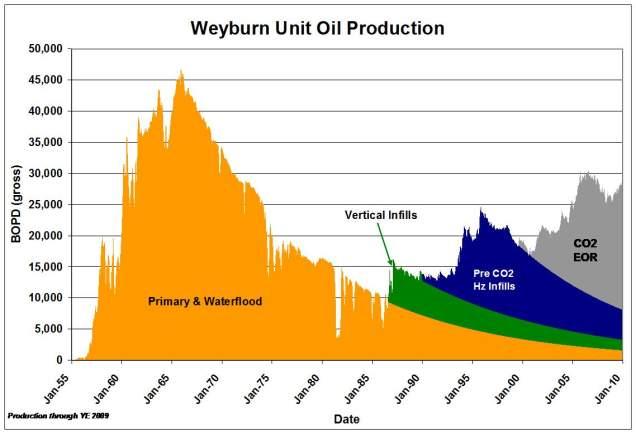Weyburn-Midale Carbon Dioxide Project
The Weyburn-Midale Carbon Dioxide Project (or IEA GHG Weyburn-Midale CO2 Monitoring and Storage Project) is, as of 2008, the world's largest carbon capture and storage project. It is located in Midale, Saskatchewan, Canada.
The IEAGHG Weyburn-Midale CO2 Monitoring and Storage Project is an international collaborative scientific study to assess the technical feasibility of CO2 storage in geological formations with a focus on oil reservoirs, together with the development of world leading best practices for project implementation. The project itself began in 2000 and runs until the end of 2011 when a best practices manual for the transitioning of CO2-EOR operations into long term storage operations will be released. The research project accesses data from the actual CO2-enhanced oil recovery operations in the Weyburn oil field (operated by Cenovus Energy of Calgary), and after the year 2005 from the adjacent Midale field (operated by Apache Canada). These EOR operations are independent of the research program. Cenovus Energy’s only contribution to the IEAGHG Weyburn-Midale CO2 Monitoring and Storage Project is to allow access to the fields for measurement, monitoring and verification of the CO2 for the global scientists and researchers involved in the project.
The Weyburn and Midale oil fields were discovered in 1954 near Midale, Saskatchewan.
The Weyburn Oilfield covers an area of some 52,000 acres (210 km2) and has a current oil production rate of ~3,067 m3/day. Original oil-in-place is estimated to be 1.4 billion barrels (220,000,000 m3). The oil is produced from a total of 963 active wells made up of 534 vertical wells, 138 horizontal wells, and 171 injection systems. There are also 146 enclosed wells. Current production consists primarily of medium-gravity crude oil with a low gas-to-oil ratio.
The Midale oil field is about 102 square miles (260 km2) in size, and has 515 million barrels (81,900,000 m3) of oil-in-place. It began injecting CO2 in 2005.
Various enhanced oil recovery techniques were used in the Weyburn field prior to the introduction of CO2, between the 1970s and 1990s. These include additional vertical drilling, the introduction of horizontal drilling, and the use of waterfloods to increase pressure in the reservoir. In October 2000, Cenovus (formerly Pan Canadian, EnCana) began injecting significant amounts of carbon dioxide into the Weyburn field in order to boost oil production. Cenovus is the operator and holds the largest share of the 37 current partners in the oilfield. The chart below illustrates the effect of the various forms of enhanced oil recovery on the production of oil (courtesy Cenovus Energy). 
...
Wikipedia
